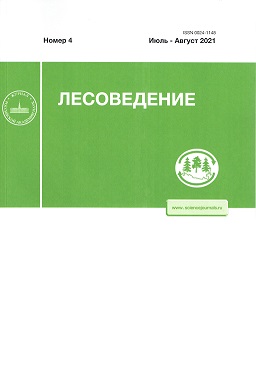ISSN: 0024-1148 Russian Journal of Forest Science. 2015, No. 6, pp. 430-435
THE EFFECT OF FIRES ON THE GROUND COVER OF LARCH AND PINE STANDS IN LOWER ANGARA REGION
N. M. Kovaleva
Forest Institute, Siberian Branch of the Russian Academy of Sciences
Academgorodok 50 bldg. 28, Krasnoyarsk, 660036, Russia
E-mail: nk-75@mail.ru
Received 11 December 2014
Larch and pine stands in boreal forests of Lower Angara Region were studied to test the effect of experimental creeping fi res of various intensity from 1800 to 4190 kW m-1 on the live ground cover at the first stage of pyrogenic succession within 1 to 3 years from the fi re. In spite of the fi re intensity the dominant species (Vaccinium vitis-idaea, Carex macroura, Rubus saxatilis, Linnaea borealis, Iris ruthenica, Calamagrostis epigeios) of the herbs and dwarf shrubs story were found at the early stage of post-fi re succession in larch and pine stands of herbs and green mosses type. Species biodiversity decreased in herbs and dwarf shrubs story within a year after the creeping fire, proportional to the fire intensity, by virtue of the losses of nondominant species which have had the projective cover below 1%. Species diversity (Shannon index) at the initial stage of post-fire succession was higher after the low and high intensity fi res, than after the moderate fi re. The fi re intensity have had significant effect on cover of herbs, shrubs and mosses. However it was growing with time after fire. The driving factor of the mosaics formation is the inhomogeneity of burning of the living ground cover for the fires of low and moderate intensity. Creeping fi res of high intensity lead to the total transformation of the lateral structure of the ground cover. Decrease in stand canopy density under the fi res of high intensity lead to the growth of projective cover and occurrence of the initial specie (Epilobium angustifolium). At the first stage of pyrogenic succession on the dead mosses cover site the micro groupings of initial species Epilobium angustifolium, Calamagrostis epigeios, Marchantia polymorpha formed.
- Keywords: fire, intensity, larch stand, ground cover.
REFERENCES
- Abaimov A. P., Prokushkin S.G., Zyryanova O.A., Ekologo-fitotsenoticheskaya otsenka vozdeistviya pozharov na lesa kriolitozony Srednei Sibiri (Ecological and phytocenotic assessment of effect fires on kriolitozona forests of Central Siberia), Sib. ekol. zhurn., 1996, No. 1, pp. 51–60.
- Dorzhsuren Ch., Krasnoshchekov Yu. N., Poslepozharnye suktsessii v psevdotaezhnykh listvennichnykh lesakh tsentral'nogo Khangaya v Mongolii (Postfire successions in the pseudo-taiga Larix forests of central Hangaya in Mongolia), Khvoinye boreal'noi zony, 2007, No. 4,5, pp. 391-397.
- Zhila S.V., Transformatsiya fitomassy v svetlokhvoinykh nasazhdeniyakh Nizhnego Priangar'ya pod vozdeistviem pozharov. Avtoref. diss. cand. biol. nauk (The transformation of biomass in softwoods of Lower Angara region after the fires. Extended abstract of candidate's biol. sci. thesis), Krasnoyarsk: IF, 2013, 20 p.
- Zhukov A.B., Korotkov I.A., Kutaf'ev V.P., Nazimova D.I., Rechan S.P., Savin E.H., Cherednikova Yu.S., Lesa Krasnoyarskogo kraya (Forests of Krasnoyarsk Region), In: Lesa SSSR (Forests of the USSR), Moscow: Nauka, 1969, Vol. 4. pp. 248–320.
- Zyryanova O.A., Abaimov A.P., Chikhacheva T.L., Vliyanie pozharov na lesoobrazovatel'nyi protsess v listvennichnykh lesakh severa Sibiri (Effect of the fires on formation of the forest in the Larix stands of the North of Siberia), Lesovedenie, 2008, No. 1, pp. 3-10.
- Ivanova G.A., Zonal'no-ekologicheskie osobennosti lesnykh pozharov v sosnyakakh Srednei Sibiri. Avtoref. diss. doc. biol. nauk (Zone and ecological features of forest fires in pine forests of Central Siberia. Extended abstract of doctor’s biol. sci. thesis), Krasnoyarsk: IF, 2005, 40 p.
- Ivanova G.A., Konard S.G., Makrae D.D., Bezkorovainaya I.N., Bogorodskaya A.V., Zhila S.V., Ivanov V.A., Ivanov A.V., Kovaleva N.M., Krasnoshchekova E.N., Kukavskaya E.A., Oreshkov D.N., Perevoznikova V.D., Samsonov Yu.N., Sorokin N.D., Tarasov P.A., Tsvetkov P.A., Shishikin A.S., Vozdeistvie pozharov na komponenty ekosistemy srednetaezhnykh sosnyakov Sibiri (Impact of the fires on ecosystem components the middle taiga pine stands of Siberia), Novosibirsk: Nauka, 2014, 232 p.
- Prokushkin S.G., Zyryanova O.A., O vliyanii derev'ev listvennitsy Gmelina na poslepozharnoe vosstanovlenie lesnogo fitotsenoza v kriolitozone Srednei Sibiri (Influence of Gmelin larch trees on postfire restoration of forest communities in the permafrost zone of Central Siberia), Sib. ekol. zhurn., 2013, No. 5, Vol. 20, pp. 645-652.
- Shmidt V.M., Matematicheskie metody v botanike (Mathematical methods in botany), Leningrad: Izd-vo Leningrad University, 1984, 288 p.
- Brassard B.W., Chen H.Y.H., Stand structural dynamics of North American boreal forests, Critical Reviews in Plant Sciences, 2006, Vol. 25, pp. 115-137.
- Gilliam F.S., The ecological significance of the herbaceous layer in temperate forest ecosystems, Bio Science, 2007, Vol. 57, No. 10, pp. 845-858.
- Gromtsev A.N., Natural disturbance dynamics in the boreal forests of European Russia: a review, Silva Fenn, 2002, Vol. 36, No. 1, pp. 41–55.
- Kenkel N.C., Walker D.J., Watson P.R., Caners R.T., Lastra R.A., Vegetation dynamics in boreal forest ecosystems, Coenoses, 1997, Vol. 12, No. 2-3, pp. 97-108.
- Korovin G.N., Analysis of the distribution of forest fires in Russia, Fire in Ecosystems of Boreal Eurasia, Dordrecht: Kluwer Academic Publishers, 1996, Vol. 48, pp. 112–128.
- McRae D., Conard S., Ivanova G., Sukhinin A., Baker S., Samsonov Y., Blake T., Ivanov V., Ivanov A., Churkina T., Hao W., Koutzenogij K., Kovaleva N., Variability of fire behavior, fire effects and emissions in Scotch Pine forests of Central Siberia, Mitigation and Adaptation Strategies for Global Change, 2006, Vol. 11, pp. 45–74.
- Ryan K.C., Dynamic interaction between forest structure and fire behavior in boreal ecosystems, Silva Fenn, 2002, Vol. 36, pp. 13–39.
- http: //www.theplantlist.org.

